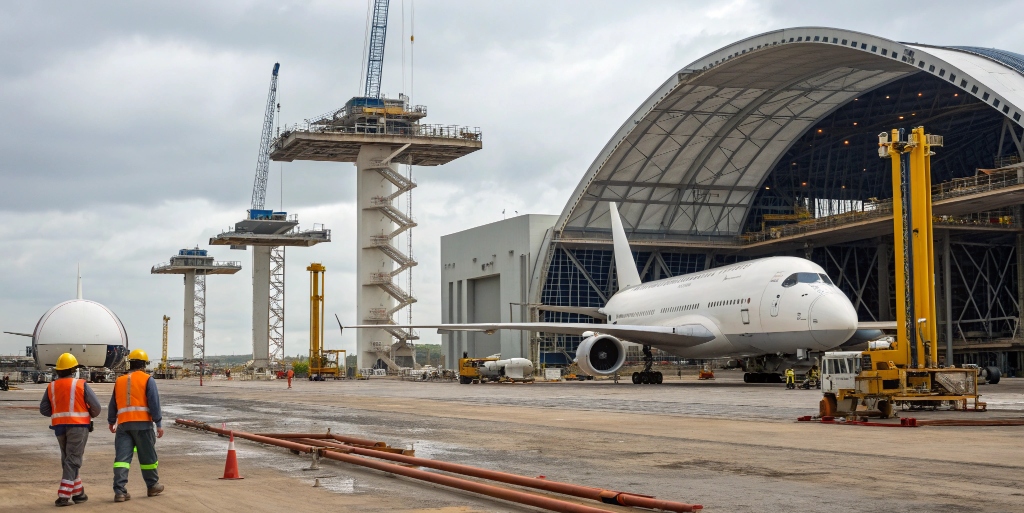Modern defense aviation requires more than advanced aircraft; it depends on facilities engineered to sustain them. Government construction for aerospace operations demands precision standards, specialized materials, and strict security protocols that support both mission readiness and long-term asset protection. These standards ensure every hangar, test bay, and maintenance center functions as part of a secure, efficient ecosystem built for continuous military operations.
Compliance with DETECT Standards for Aviation-sustainment Facilities
Defense agencies rely on the DETECT framework to define the technical and safety benchmarks for aviation-sustainment environments. These standards govern everything from lighting and floor load capacity to noise suppression and airflow control. Meeting DETECT ensures that facilities can handle the stress of maintenance cycles while maintaining safety for crews working with high-performance aircraft.
Construction teams working under government contracts apply DETECT principles through detailed inspections and engineering reviews at each project milestone. The intent is to guarantee consistency across all military bases, whether the site supports tactical jets or transport aircraft. This compliance demonstrates how global construction firms coordinate design and performance to align with defense mission goals.
Material and Structural Criteria Tailored for High-stress Aerospace Assets
Aircraft hangars and test bays must endure vibration, torque, and weight loads far beyond those seen in typical commercial buildings. Structural frameworks often use reinforced concrete, high-tensile steel, and advanced composites to handle these demands. Material specifications are defined by strict government construction codes to maintain structural stability under operational strain.
Such buildings are also designed for adaptability. Load-bearing frames, modular truss systems, and vibration-isolating foundations allow engineers to modify layouts as fleets evolve. For international construction company teams, this adaptability is essential to meet future defense technology upgrades without disrupting current missions.
Environmental-control systems designed for corrosion mitigation of fighter aircraft
Corrosion control remains one of the most overlooked challenges in aerospace facility design. Government standards require advanced humidity regulation, filtration, and airflow systems to protect aircraft finishes and electronic components from oxidation. These environmental-control systems ensure surfaces remain clean and temperature-stable during long maintenance or refit cycles.
In defense hangars, air handling units are paired with anti-corrosive coatings, sealed floor membranes, and negative-pressure ventilation to manage contaminants. Maintaining this balance keeps metal fatigue at bay and safeguards millions of dollars in aircraft investments. For defense programs operating globally, the consistency of these systems defines operational reliability.
Secure Access and Construction Zones Meeting DoD and Ballistic Requirements
Facility security begins before the first wall goes up. Military construction follows Department of Defense guidelines for controlled access, hardened perimeters, and ballistic-resistant design. Contractors must coordinate with federal security agencies to verify all materials, personnel, and site plans before approval.
Security features include reinforced entryways, blast-rated walls, and limited sightlines between restricted areas. These measures create layers of protection without hindering workflow. For a company delivering government construction projects worldwide, maintaining this balance between accessibility and protection ensures each site complies with the highest federal standards.
Workflow-oriented Layouts Accommodating Rapid Aircraft Teardown and Rebuild
Efficiency in an aircraft maintenance hangar comes down to layout. Spaces must support the rapid movement of personnel, tools, and components. Workflow-oriented design places utilities, lifts, and support stations exactly where technicians need them, minimizing downtime between operations.
Each layout is shaped around the aircraft type it serves. Fighter maintenance bays differ from cargo aircraft depots in clearance height, wing span access, and work zone configuration. These workflow efficiencies are engineered into construction plans from the start, reflecting the operational tempo expected at defense facilities.
Embedded Latent-load Capacity Built into Infrastructure for Future Fleet Upgrades
Government facilities are rarely static. To accommodate future aircraft generations or new mission equipment, engineers design structures with embedded latent-load capacity. This hidden strength allows a facility to support heavier equipment, larger vehicles, or new technologies without full reconstruction.
Designing for future adaptability protects the government’s long-term investment. It gives defense agencies the flexibility to integrate innovations like electric ground systems or autonomous maintenance tools without major disruption. For firms managing global construction portfolios, this foresight demonstrates technical maturity and understanding of mission longevity.
Accredited Quality-management Systems Overseeing Every Construction Phase
Government construction projects operate under accredited quality-management systems that verify every phase from design to completion. These frameworks, often modeled on ISO or MIL-SPEC standards, require measurable performance audits and documentation trails. Quality oversight ensures that each weld, conduit, and panel aligns with approved defense specifications.
Contractors use layered inspection checkpoints and independent validation teams to confirm compliance before final turnover. This disciplined approach prevents rework, reduces risk, and ensures that the facility meets both structural and operational benchmarks established by defense authorities.
Documentation Trails Aligned with Federal Acquisition and Asset-tracking Mandates
Documentation is as vital as the structure itself. Federal acquisition regulations demand that every material batch, inspection, and approval is logged for transparency and future reference. These documentation trails form the foundation of asset tracking across multiple installations.
Accurate recordkeeping helps defense agencies manage maintenance schedules and future upgrades. It also supports accountability across international construction company projects, where consistency and auditability are required by law. The alignment of records and regulatory mandates guarantees that government construction projects can withstand both physical and procedural scrutiny.
Through these layers of compliance, technical precision, and forward-focused design, Nav Int continues to define what modernization means for aerospace infrastructure. As a leader in global construction serving government and defense programs, Navigator International remains instrumental in building the facilities that sustain the future of flight.



